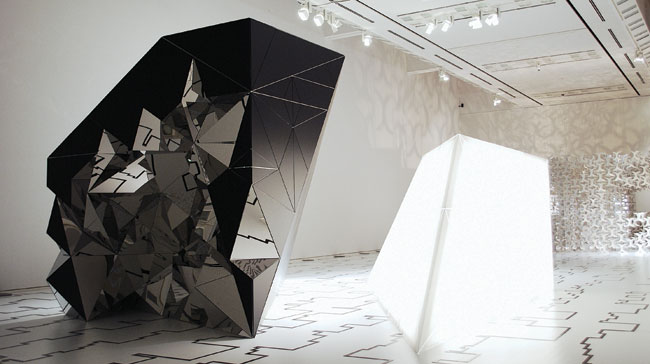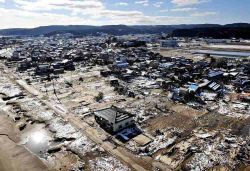
February 18, 2010
Cecil Balmond
An architectural genius gets placed on a pedestal at Tokyo Opera City
By Metropolis
Originally published on metropolis.co.jp on February 2010
There will always be a demand for people like Cecil Balmond, the British mathematical genius and structural engineer behind some of the most eye-catching architectural projects of the last several decades. Working with a range of famous architects, including Philip Johnson, Rem Koolhaas, Alvaro Siza, and Japan’s Toyo Ito, Balmond has developed his role of adding practical know-how to the fanciful, attention-grabbing schemes of these visionaries.
So important has the engineer’s contribution been that in projects like Beijing’s astounding (but still unopened) CCTV Building, he has been treated as an equal collaborator and co-creator. Now considered an important architect in his own right, Balmond is being honored with a solo exhibition at the Tokyo Opera City Art Gallery.
Balmond’s work is an ideal opportunity to explain some of the mathematical mysteries of advanced architecture, while his life story—born in Sri Lanka before moving to Nigeria and finally to England in 1968, where he joined the Arup engineering firm then involved in the structural design of the Sydney Opera House—could present a fascinating insight into a truly cosmopolitan figure. Unfortunately, the exhibition avoids both these obvious avenues with a show that mistakenly attempts to mesmerize and mystify, treating architecture like some kind of arcane alchemy.
This approach is signaled at the entrance, where visitors enter a maze made from curtains printed with various organic patterns and wordy snippets of the architect’s not always down-to-earth philosophy.
“What makes the telling fresh each time is the bias we put on the observed facts,” reads one of the curtains. “These facts are wrapped up in patterns—that is why we remember so well and can reinvent the telling. The patterns are codes.”
While intriguing and occasionally illuminating, this approach is ineffective in conveying Balmond’s architectural achievement, which is essentially founded on his deep understanding of mathematics and materials. Employing algorithms and fractal geometry, he creates structural patterns that are able to bend in all the right places without breaking.
Mathematical terminology like this sounds daunting, and perhaps explains why TOC has attempted to recast Balmond as a kind of shamanistic poet. But, for the architect himself, there is little mystery to mathematics.
“Algorithms are the new science,” he told Metropolis’ US-based namesake in 2007, “but they’re nothing new. Algorithms are the oldest thing in the world. If you count, it’s an algorithm, 1 + 1, 1 + 1 + 1. Our numbers are algorithmic. If you do any ballroom dancing, if you repeat yourself in a sequence, that’s an algorithm.”
If the curators had taken an approach like this—attempting to show the simplicity in the complexity—they would have done Balmond more justice. Instead, the exhibition seems to aim at sensual appreciation. A large space is given over to recreate H_edge, a construction composed of chains held rigid by H-shaped pieces of metal, reminiscent of an Indian rope trick, and Danzer, an installation comprising two large, multifaceted geometric blocks. This allows us to taste the atmosphere of Balmond’s architectural universe but, with little to guide us, we end up feeling lost in an alien realm.
The most important section of the show should be the part focusing on his long career with Arup and his numerous major projects. In addition to the CCTV Building, these include other mind-bending collaborations like Marysas, a 150-meter-long, 10-story-high artwork that he helped the artist Anish Kapoor create at London’s Tate Modern Museum in 2002, as well as adventurous solo projects like his zigzagging Coimbra Bridge in Portugal.
However, instead of using this wealth of work to cast light on the workings of Balmond’s architectural grey matter, it is instead relegated to a row of two-dimensional display boards in a corridor at the end of the exhibition. Rather than showing us Balmond’s genius, this exhibition merely asks us to believe in it.
Tokyo Opera City Art Gallery
The World of Structural Engineer Cecil Balmond. Various media. Until Mar 22, ¥600 (elem, MS)/¥1,000 (HS, univ)/¥1,200 (adult). From the Collection: My Old Rivers and Mountains Home, Part II. Painting. Until Mar 22, free (with Balmond admission). Project N 40: Naoto Kumagai. Painting. Until Mar 22, free (with Balmond admission). 3-20-2 Nishi-Shinjuku, Shinjuku-ku. Tel: 03-5353-0756. Open Tue-Thu 11am-7pm, Fri & Sat until 8pm, closed Mon. Nearest stn: Hatsudai. www.operacity.jp









